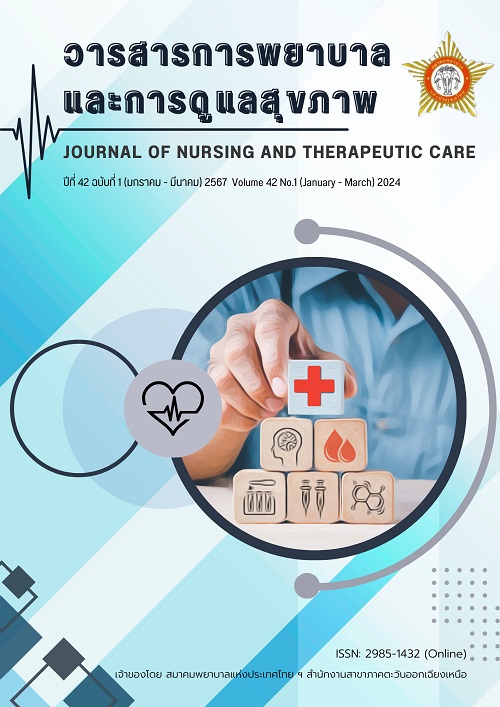ผลของการใช้สื่อการสอนแฮมเบอร์เกอร์โมเดลข้าวหลามโมเดลในการเรียนวิชากายวิภาคศาสตร์และสรีรวิทยาต่อผลสัมฤทธิ์ทางการเรียนและความพึงพอใจต่อการเรียนของนักศึกษาพยาบาล
คำสำคัญ:
กายวิภาศาสตร์และสรีรวิทยา, เครือข่ายบริการสุขภาพ, ข้าวหลามโมเดล, ผลสัมฤทธิ์การเรียนรู้, นักศึกษาพยาบาลบทคัดย่อ
การศึกษาผลของการใช้สื่อการสอนแฮมเบอร์เกอร์โมเดลและข้าวหลามโมเดลในการเรียนวิชากายวิภาคศาสตร์และสรีรวิทยาเป็นการวิจัยกึ่งทดลองมีวัตถุประสงค์เพื่อ 1) เปรียบเทียบผลสัมฤทธิ์ทางการเรียนวิชากายวิภาคศาสตร์และสรีรวิทยาของนักศึกษาพยาบาลศาสตร์ก่อนเรียนและหลังเรียนโดยการใช้สื่อการสอนแฮมเบอร์เกอร์โมเดลแสดงโครงสร้างของเซลล์และข้าวหลามโมเดลแสดงโครงสร้างของเซลล์กล้ามเนื้อ 2) ศึกษาความพึงพอใจของนักศึกษาต่อการเรียนวิชากายวิภาคศาสตร์และสรีรวิทยาของนักศึกษาพยาบาลศาสตร์ในการใช้สื่อการสอนแฮมเบอร์เกอร์โมเดล ข้าวหลามโมเดล กลุ่มตัวอย่างเป็นนักศึกษาพยาบาลที่ลงทะเบียนเรียนรายวิชากายวิภาคศาสตร์และสรีรวิทยา วิทยาลัยพยาบาลบรมราชนนี สุราษฎร์ธานี ชั้นปีที่ 1 ภาคเรียนที่ 1 ปีการศึกษา 2565 จำนวน 34 คน ได้มาจากการจากการเลือกแบบเจาะจง เรียนรู้โดยใช้แฮมเบอร์เกอร์โมเดล ข้าวหลามโมเดล เครื่องมือที่ใช้ในการวิจัย แบบทดสอบวัดผลสัมฤทธิ์ทางการเรียนและแบบวัดความพึงพอใจการเรียนรู้โดยใช้สื่อการสอนแฮมเบอร์เกอร์โมเดล ข้าวหลามโมเดล วิเคราะห์หาความยากง่ายของแบบทดสอบ ระดับดีถึงดีมาก p = 0.4–0.6 และค่าอำนาจจำแนกที่มี ค่า 0.4 ขึ้นไป นำแบบทดสอบที่ผ่านการคัดเลือกมาวิเคราะห์ค่าความเชื่อมั่น ของแบบทดสอบ โดยใช้สูตร KR-20 ของคูเดอร์-ริชาร์ดสัน มีค่าความเชื่อมั่นที่ .75 วิเคราะห์ข้อมูลด้วยการหาค่าเฉลี่ย ส่วนเบี่ยงเบนมาตรฐานและการทดสอบค่าที
ผลการวิจัยพบว่า 1) ผลสัมฤทธิ์ทางการเรียนของนักศึกษาพยาบาลที่ได้รับการเรียนรู้โดยใช้แฮมเบอร์เกอร์โมเดลและข้าวหลามโมเดลมีคะแนนเฉลี่ยหลังเรียนด้วยสื่อการสอนสูงกว่าก่อนเรียนอย่างมีนัยสำคัญทางสถิติที่ระดับ .001 และ 2) นักศึกษามีความพึงพอใจต่อการเรียนรู้โดยใช้สื่อการสอนแฮมเบอร์เกอร์โมเดลข้าวหลามโมเดลอยู่ในระดับมากที่สุด ดังนั้นจึงควรใช้สื่อการสอนแฮมเบอร์เกอร์โมเดลและข้าวหลามโมเดลในการจัดการเรียนสอนเนื่องจากเป็นสื่อที่หาได้ง่ายในชีวิตประจำวันนักศึกษาสามารถใช้ทบทวนสาระการเรียนรู้ได้ด้วยตนเอง
Downloads
เอกสารอ้างอิง
Hemtong W, Thongphet S, Tunit P, Sirited P. Effect of using synthetic human cadaver in anatomy of muscular system on learning achievements and satisfaction of nursing students. Academic Journal of Phetchaburi Rajabhat University. 2022;12(1):31-8. (in Thai)
Watcharinrat M, Uruwan S, Choopan W. Comparisons of achievement of anatomy laboratory learning by cadaver and anatomy application on digestive system with first year nursing students of private university in Nakhon Pathom. Journal of Education. 2019;30(3):49-62. (in Thai)
Ministry of Education. National education act, B.E. 2542.Amendment No. 2, B.E. 2002. Bangkok: Teachers' council of Ladprao printing house; 1999. (in Thai)
Kristine GH, Christoffersen TE, Ringstad O, Andreason M, Lugo RG. A blended learning teaching strategy strengthens the nursing students’ performance and self-reported learning outcome achievement in an anatomy, physiology and biochemistry course – a quasi-experimental study. Nurs Educ Pract. 2021;52:103046.
Joseph MA, Roach EJ, Natarajan J, Karkada S, Cayaban AR. Flipped classroom improves Omani nursing students performance and satisfaction in anatomy and physiology. BMC nursing. 2021;20:1.
Satoh M, Fujimura A, Miyagawa S. Difficulties and innovations in teaching anatomy and physiology in nursing. Nurse Educ Pract. 2023;67:103551.
Kidhathong S, Tonkuriman A. Effectiveness of using multimedia as co-teaching on nursing students’ knowledge and skills in therapeutic relationships and communication nursing. Nursing Journal of the Ministry of Public Health. 2022;32(1):14-26. (in Thai)
Kulnithichai W, Kosanawat S. Development of a multimedia lesson to enhance learning skills in basic anatomy of the skeletal system of second year nursing students at the University of Phayao. Journal of The Royal Thai Army Nurses 2017;18(2):186-93. (in Thai)
Thuanthong T. The development of instructional media to enhance knowledge in anatomy of nervous system for nursing students. Journal of Legal Entity Management and Local Innovation. 2023;9(8):203-13. (in Thai)
Watcharinrat M, Uruwan S, Choopan W. Comparisons of achievement of anatomy laboratory learning By cadaver and anatomy application on digestive system with first year nursing students of private university in Nakhon Pathom. Journal of Education. 2019;3(3):49-62. (in Thai)
Gritcharoen J. Applying augmented reality for anatomy teaching and learning. Srinagarind Med J. 2020;35(1):98-102. (in Thai)
Phillips AW, Smith SG, Ross CF, Straus CM. Direct correlation of radiologic and cadaveric structures in a gross anatomy course. Med Teach. 2012;34:e779-84
Kunoi C. Development of electronic media in teaching and learning physical subjects. anatomy and physiology for nursing students Boromarajonani College of Nursing Chakrirat. Nursing Journal of public health and education. 2019;20(3):174-86. (in Thai)
Potisaen J, Potisaen T. Effects of using instructional games on vocabulary in human anatomy and physiology in sports science students at Rajabhat Maha Sarakham University, Thailand. Journal of Education Rajabhat Maha Sarakham University. 2020;17(32):520-40. (in Thai)
Kawiwitchai C, Dejpraphon M, Kositthaphiwat C, Ruenwongsa P, Panitchaphan P. Computer lesson development teaching multimedia that integrates knowledge in anatomy and physiology to promote nursing students' skills in physical examination. Adults: Head and neck examination.Ramathibodi Nursing Journal. 2013;19(3):428-43. (in Thai)
Anantatiwet S, Tubtimthong W, Sinmuk U. Development of video media according to the concept. ADDIE Model: Nursing care of premature infants at high risk. Journal of nursing and education. 2021;14(4):64-77. (in Thai)
Boonkusol T, Intawat J. The Effects of learning techniques using the activity package for anatomy and physiology subjects to enhance the analytical thinking ability and satisfaction of nursing students. The Journal of Baromarajonani College of Nusing, Nakhonratchasima. 2017;23(1):85-96. (in Thai)
Thongtaninkwan R, Inted W, Thamta A, Boonkaew J, Jaiwandee W, Harnsiriwattanakit K, et al. Factors related to human gross anatomy knowledge retention in medical students. Chulalongkorn Medical Journal. 2018;62(3):593-605. (in Thai)
Thongsapaya S, Boonkusol T. The effectiveness of inquiry –based learning 5E teaching model in Human anatomy and physiology to enhance analytical thinking and satisfaction of nursing students. UBRU Journal for Public Health Research. 2019;8(2):89-97. (in Thai)
Wassanasompong W, Intaraprasert D, Viratsetsin K. The effect of Learning Learning model for happiness of Learning by C2G technique on cognitive domain based on concept of Benjamin S. Bloom in anatomy and physiology subjects. Journal of Social Science and Buddhistic Anthropology. 2020; 5(12):44-62. (in Thai)
ดาวน์โหลด
เผยแพร่แล้ว
รูปแบบการอ้างอิง
ฉบับ
ประเภทบทความ
สัญญาอนุญาต
ลิขสิทธิ์ (c) 2024 วารสารการพยาบาลและการดูแลสุขภาพ

อนุญาตภายใต้เงื่อนไข Creative Commons Attribution-NonCommercial-NoDerivatives 4.0 International License.



